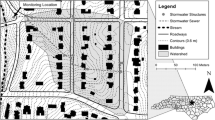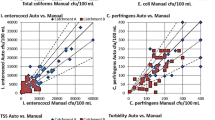Abstract
An urban watershed in Raleigh, NC, was evaluated for Escherichia coli (E. coli), fecal coliform, enterococci, and total suspended solids (TSS) over 20 storm events. Sampling procedures allowed collection of multiple discrete samples per event, resulting in a relatively detailed description of microbe and TSS export for each storm. Data were evaluated to determine if a first flush effect was present for indicator bacteria and TSS in stormwater runoff. Analyses suggested there was a significant first flush effect for fecal coliform and TSS, although the first flush effect for fecal coliform was relatively weak. For E. coli and enterococci, no significant first flush effect was noted. Overall, the first flush effect was not always present for indicator bacteria and, if present, tended to be weak. The first flush effect for TSS was substantially stronger than that of any indicator bacteria. Further analysis showed poor correlation between first flush strength and antecedent climate variables, storm characteristics, and flow characteristics. However, seasonal differences for first flush strength were noted. Specifically, winter storms showed a stronger first flush effect for all indicator bacteria. The results of this study indicate that stormwater runoff presents a potential public health hazard due to elevated indicator bacteria levels for all portions of the storm event. Further, stormwater management practices cannot be expected to treat proportionally more indicator bacteria when sized for the water quality event. Instead, removal will simply be a function of a management practice’s volume capture and microbe sequestration efficiency.





Similar content being viewed by others
References
American Public Health Association, American Water Works Association, and Water Environment Federation (APHA, AWWA, and WEF). (1998). Standard methods for the examination of water and wastewater (20th ed.). Alexandria: American Public Health Association.
Australian Bureau of Meteorology (ABOM). (2010). Climate statistics for Australian locations: summary statistics for Melbourne regional office. http://www.bom.gov.au/climate/averages/tables/cw_086071.shtml (February 16, 2010).
Barrett, M. E., Irish, L. B., Jr., Malina, J. F., Jr., & Charbeneau, R. J. (1998). Characterization of highway runoff in Austin, Texas, area. Journal of Environmental Engineering, 124(2), 131–137.
Bertrand-Krajewski, J., Chebbo, G., & Saget, A. (1998). Distribution of pollutant mass vs volume in stormwater discharges and the first flush phenomenon. Water Research, 32(8), 2341–2356.
California Department of Transportation. (2000). First FLUSH STUDY 1999–2000 Report. Rep No. CTSW-RT-00-016, Division of Environmental Analysis, Sacramento, CA.
Characklis, G. W., & Wiesner, M. R. (1997). Particles, metals, and water quality in runoff from large urban watershed. Journal of Environmental Engineering, 123(8), 753–759.
Characklis, G. W., Dilts, M. J., Simmons, O. D., III, Likirdopulos, C. A., Krometis, L. H., & Sobsey, M. D. (2005). Microbial partitioning to settleable particles in stormwater. Water Research, 39, 1773–1782.
Crane, S. R., & Moore, J. A. (1986). Modeling enteric bacterial die-off: a review. Water, Air, and Soil Pollution, 27, 411–439.
Davies, C. M., & Bavor, H. J. (2000). The fate of stormwater-associated bacteria in constructed wetland and water pollution control pond systems. Journal of Applied Microbiology, 89, 349–360.
Deletic, A. (1998). The first flush load of urban surface runoff. Water Research, 32(8), 2462–2470.
Haydon, S., & Deletic, A. (2006). Development of a coupled pathogen-hydrologic catchment model. Journal of Hydrology, 328, 467–480.
Flint, K. R., & Davis, A. P. (2007). Pollutant mass flushing characterization of highway stormwater runoff from an ultra-urban area. Journal of Environmental Engineering, 133(6), 616–626.
Hathaway, J. M., Hunt, W.F., and Simmons O.D. III. (2010). Statistical evaluation of factors affecting indicator bacteria in urban stormwater runoff. Journal of Environmental Engineering (in press).
Lee, J. H., Bang, K. W., Ketchum, L. H., Choe, J. S., & Yu, M. J. (2002). First flush analysis of urban storm runoff. The Science of the Total Environment, 293, 163–175.
Jan, C., Chang, C., & Lee, M. (2006). Discussion of ‘design and calibration of a compound sharp-crested weir’ by J. Martinez, J. Reca, M.T. Morillas, and J.G. Lopez. Journal of Hydraulic Engineering, 132(8), 868–871.
Krometis, L. A., Characklis, G. W., Simmons, O. D., III, Dilts, M. J., Likirdopulos, C. A., & Sobsey, M. D. (2007). Intra-storm variability in microbial partitioning and microbial loading rates. Water Research, 41(2), 506–516.
Maestre, A., Pitt, R., & Williamson, D. (2004). Nonparametric statistical tests comparing first flush and composite samples from the national stormwater quality database. In W. James (Ed.), Innovative modeling of urban water systems (Vol. 12, pp. 317–338). Guelph: CHI.
Mankin, K. R., Wang, L., Hutchinson, S. L., & Marchin, G. L. (2007). Escherichia coli sorption to sand and silt load soil. Transactions of the ASABE, 50(4), 1159–1165.
McCarthy, D. T. (2008). Modelling microorganisms in urban stormwater. Doctoral dissertation, Monash University, Melbourne, Australia.
McCarthy, D. T. (2009). A traditional first flush assessment of E. coli in urban stormwater runoff. Water Science and Technology, 60(11), 2749–2757.
McCarthy, D. T., Deletic, A., Mitchell, V. G., Fletcher, T. D., & Diaper, C. (2008). Uncertainties in stormwater E. coli levels. Water Research, 42, 1812–1824.
National Oceanic and Atmospheric Administration (NOAA). (2009). Vapor pressure calculator. http://www.srh.noaa.gov/epz/?n=wxcalc_vaporpressure (Nov. 18, 2009).
Sansalone, J. J., & Buchberger, S. G. (1997). Partitioning and first flush of metals in urban roadway storm water. Journal of Environmental Engineering, 123(2), 134–143.
Sansalone, J. J., & Cristina, C. M. (2004). First flush concepts for suspended and dissolved solids in small impervious watersheds. Journal of Environmental Engineering, 130(11), 1301–1314.
SAS Institute Inc. 2001. The SAS system for Windows (Release 9.1), Cary, NC.
Selvakumar, A., & Borst, M. (2006). Variation of microorganism concentrations in urban stormwater runoff with land use and seasons. Journal of Water and Health, 4(1), 109–124.
State Climate Office of North Carolina (SCONC). (2009). 1971–2000 Climate Normals. http://www.nc-climate.ncsu.edu/cronos/normals.php?station=317079 (Nov. 18, 2009).
Stenstrom, M. K., Silverman, G. S., & Bursztynsky, T. A. (1984). Oil and grease in urban stormwaters. Journal of Environmental Engineering, 110(1), 58–72.
United States Environmental Protection Agency (USEPA). (2008). Water quality assessment and total maximum daily loads information (ATTAINS). http://www.epa.gov/waters/ir/index.html (November 29, 2008).
Wake County and City of Raleigh (WCCOR). (2010). Imaps. http://imaps.co.wake.nc.us/imaps/ (February 16, 2010).
Wanielista, M. P., & Yousef, Y. A. (1993). Stormwater management. New York: Wiley.
Yacub, G. P., Castric, D. A., Stadterman-Knauer, K. L., Tobin, M. J., Blazina, M., Heineman, T. N., et al. (2002). Evaluation of Colilert and Enterolert defined substrate methodology for wastewater applications. Water Environment Research, 74(2), 131–135.
Acknowledgements
The authors would like to recognize the North Carolina Department of Environment and Natural Resources for funding this project. The authors also thank Dr. Otto Simmons for assistance with bacteria analysis protocols and Shawn Kennedy for his work installing monitoring equipment.
Author information
Authors and Affiliations
Corresponding author
Rights and permissions
About this article
Cite this article
Hathaway, J.M., Hunt, W.F. Evaluation of First Flush for Indicator Bacteria and Total Suspended Solids in Urban Stormwater Runoff. Water Air Soil Pollut 217, 135–147 (2011). https://doi.org/10.1007/s11270-010-0574-y
Received:
Accepted:
Published:
Issue Date:
DOI: https://doi.org/10.1007/s11270-010-0574-y




